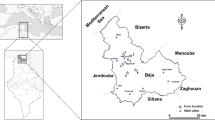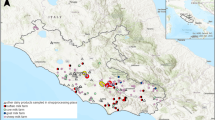Abstract
Levels of polychlorinated dibenzo-p-dioxins (PCDDs), polychlorinated dibenzofurans (PCDFs), and polychlorobiphenyls (PCBs) were determined in samples of bovine and ovine milk collected in farms located in the province of Grosseto, Tuscany, in the vicinity of two incineration plants as well as in farms located in areas with presumable background levels of contamination. Samples of feedstuffs of local origin used in the investigated farms were also collected and analysed. The cumulative levels of PCDDs, PCDFs, and dioxin-like PCBs (DL-PCBs) in feedstuffs ranged from 0.25 to 0.61 pg WHO-TE/g fresh weight (fw) in the farms under impact from incinerator emissions and from 0.21 to 0.34 pg WHO-TE/g fw in the control area farms. The sums of the six non–dioxin-like indicator PCB (NDL-PCB) congeners were 0.13 to 9.3 ng/g fw and 1.2 to 1.9 ng/g fw, respectively. In milk samples, the levels detected were 0.71 to 2.9 pg WHO-TE/g fat and 0.52 to 0.59 pg WHO-TE/g fat in farms under impact from the incinerators and in the control area farms, respectively. The corresponding sums of the six indicator PCB congeners were 1.4 to 8.2 ng/g fat and 0.90 to 1.6 ng/g fat. In all samples, contamination levels were below the limits set by the European Community (EC; Commission Directive 2006/13/EC and Commission Regulation 1881/2006/EC.) No relevant differences were found between samples collected in potentially exposed areas and control areas for total toxic equivalents and cumulative analytic levels of PCDDs, PCDFs, DL-PCBs, and NDL-PCBs (p > 0.05, Mann-Whitney U test). Observed levels were in agreement with those found in other countries in areas with background levels of exposure. Congener levels and profiles of PCDDs, PCDFs, and PCBs in feedstuffs and milk samples that were compared describe congener-specific transfer behavior.


Similar content being viewed by others
References
Andre F, Marchand P, Venisseau A, Brosseaud A, Matayron G, Laplanche A, Le et al (2004) Study of PCDD/Fs, dioxin-like and markers PCBs levels in cow’s milks collected in farms in the neighbourhood of municipal solid waste incinerators. Organohal Comp 66:1940–1946
Commission Directive 2006/13/EC (2006) Commission directive amending annexes I and II to directive 2002/32/EC of the European Parliament and of the Council on undesirable substances in animal feed as regards dioxins and dioxin-like PCBs
Commission Directive 2000/76/EC (2000) Directive of the European Parliament and of the Council on the incineration of waste
Commission Recommendation 2006/88/CE (2006) Commission recommendation on the reduction of the presence of dioxins, furans and PCBs in feedingstuffs and foodstuffs
Commission Regulation 1881/2006/EC (2006) Commission regulation setting maximum levels for certain contaminants in foodstuffs
Costera A, Feidt C, Marchand F, Le Bizec B, Rychen G (2006) PCDD/F and PCB transfer to milk in goats exposed to a long-term intake of contaminated hay. Chemosphere 64:650–657. doi:10.1016/j.chemosphere.2005.10.052
De Felip E, Abballe A, Casalino F, di Domenico A, Domenici P, Iacovella N, et al (2008) Serum levels of PCDDs, PCDFs and PCBs in non-occupationally exposed population groups living near two incineration plants in Tuscany, Italy. Chemosphere 72:25–33
Domingo JL, Granero S, Schuhmacher M (2001) Congener profiles of PCDD/Fs in soil and vegetation samples collected near to a municipal waste incinerator. Chemosphere 43:517–524. doi:10.1016/S0045-6535(00)00403-3
Dowding A, Foxall C, Fernandes A, Lake I, Lovett A, White S et al (2006) The effects of river flooding on the congener patterns of dioxins in soil, herbage, and cows’ milk from flood-prone farms. Organohal Comp 68:440–443
European Food Safety Agency (2005) Opinion of the scientific panel on contaminants in the food chain on a request from the commission related to the presence of non dioxin-like polychlorinated biphenyls (PCBs) in feed and food. EFSA J 284:1–137
Fattore E, Fanelli R, Turrini A, di Domenico A (2006) Current dietary exposure to polychlorodibenzo-p-dioxins, polychlorodibenzofurans, and dioxin-like polychlorobiphenyls in Italy. Mol Nutr Food Res 50:915–921. doi:10.1002/mnfr.200500212
Fattore E, Fanelli R, Dellatte E, Turrini A, di Domenico A (2008) Assessment of the dietary exposure to non-dioxin-like PCBs of the Italian general population. Chemosphere 78:S278–S283
Fries GF, Paustenbach DJ, Mather DB, Luksembur WJ (1999) A congener specific evaluation of transfer of chlorinated dibenzo-p-dioxins and dibenzofurans to milk of cows following ingestion of pentachlorophenol-treated wood. Environ Sci Technol 33:1165–1170. doi:10.1021/es981153d
Gallani B, Boix A, di Domenico A, Fanelli R (2004) Occurrence of NDL-PCB in food and feed in Europe. Organohal Comp 66:3610–3618
Jilg T, Müller W, Hagenmaier H, Päpke O (1992) Carry-over of polychlorinated dibenzodioxins (PCDD) and dibenzofurans (PCDF) from feed into the milk of the dairy cow. Agribiol Res 45:303–310
Marchand P, Costera A, Vénisseau A, Feidt C, Brosseaud A, Rychen G, Le Bizec B (2005) Levels of PCDD/Fs and PCBs in goat’s milk exposed to a chronic intake of contaminated hay. Organohal Comp CD ID 1090:1442–1445
McLachlan M (1997) A simple model to predict accumulation of PCDD/Fs in an agricultural food chain. Chemosphere 34:1263–1276 doi:10.1016/S0045-6535(97)00424-4
O’Keefe PW, Hilker D, Aldous K, Storm R, Abbott J, Chinery R et al (2003) Concentrations of PCDDs AND PCDFs in cow’s milk collected from farms near municipal incinerators in New York State. Organohal Comp 64:5–8
Rappolder M, Brüders N, Schröter-Kermani C (2005) Comparison of congener patterns and TEQs in environmental and human samples. Organohal Comp 67:2086–2089
Richter S, Johnke B (2004) Status of PCDD/F-emission control in Germany on the basis of the current legislation and strategies for further action. Chemosphere 54:1299–1302. doi:10.1016/S0045-6535(03)00247-9
Schmid P, Gujer E, Zennegg M, Studer C (2003) Temporal and local trends of PCDD/F levels in cow’s milk in Switzerland. Chemosphere 53:129–136. doi:10.1016/S0045-6535(03)00439-9
Scire J, Yamartino R, Strimaitis D (1999) A user’s guide for the CALPUFF meteorological model (version 5.5). Earth Tech, Concord, MA
Stachel B, Christoph EH, Götz R, Herrmann T, Krüger F, Kühn T et al (2006) Contamination of the alluvial plain, feeding-stuffs and foodstuffs with polychlorinated dibenzo-p-dioxins, polychlorinated dibenzofurans (PCDD/Fs), dioxin-like polychlorinated biphenyls (DL-PCBs) and mercury from the River Elbe in the light of the flood event in August 2002. Sci Total Environ 364:96–112. doi:10.1016/j.scitotenv.2005.07.004
Thomas GO, Sweetman AJ, Jones KC (1999) Metabolism and body-burden of PCBs in lactating dairy cows. Chemosphere 39:1533–1544. doi:10.1016/S0045-6535(99)00050-8
United States Environmental Protection Agency (1994) Method 1613, Revision B. Tetra through octa-chlorinated dioxins and furans by isotope dilution HRGC/HRMS. Environmental Protection Agency, Office of Water Engineering and Analysis Division (4303), Washington, DC
Van den Berg M, Birnbaum L, Bosveld AT, Brunström B, Cook P, Feeley M et al (1998) Toxic equivalency factors (TEFs) for PCBs, PCDDs, PCDFs for humans and wildlife. Environ Health Perspect 106:775–792. doi:10.2307/3434121
World Health Organization (1992) Polychlorinated biphenyls and terphenyls, 2nd ed. Environmental health criteria 140. International Programme on Chemical Safety, World Health Organization, Geneva, Switzerland
Acknowledgments
This study was supported by Provincia di Grosseto and Fondazione Monte dei Paschi di Siena. The authors thank D. Burgassi, D. Corsini, and G. Pugliano from Azienda Sanitaria Locale 9 (ASL 9) and S. De Luca and A. R. Fulgenzi from ISS for their technical support.
Author information
Authors and Affiliations
Corresponding author
Rights and permissions
About this article
Cite this article
Ingelido, A.M., Abballe, A., di Domenico, A. et al. Levels and Profiles of Polychlorinated Dibenzo-p-Dioxins, Polychlorinated Dibenzofurans, and Polychlorinated Biphenyls in Feedstuffs and Milk From Farms in the Vicinity of Incineration Plants in Tuscany, Italy. Arch Environ Contam Toxicol 57, 397–404 (2009). https://doi.org/10.1007/s00244-008-9262-y
Received:
Accepted:
Published:
Issue Date:
DOI: https://doi.org/10.1007/s00244-008-9262-y




